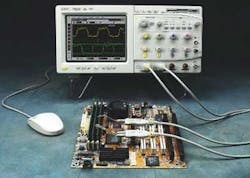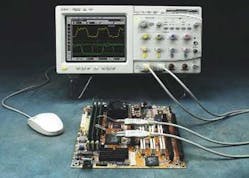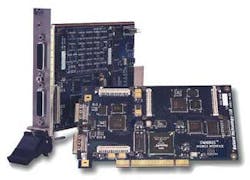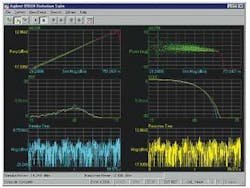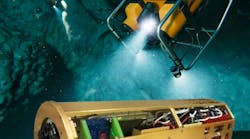By Ben Ames
As they face a slumping economy and aging weapons systems, military electronics designers are asking for ever-greater flexibility from their test and measurement equipment.
In fact, the line between military and commercial applications is blurring, as designers try to save time and money by mixing components.
"It's a more fuzzy line than there used to be between full-blown mil-spec 883 and early generation DOS running at just a few sample rates per second," says Kevin Christian, customer services manager at Ballard Technology Inc. in Everett, Wash.
"It's more of a mix now, because you see more military electronics on commercial planes, and vice versa," Christian says. "On 767 tankers, AWACS, and Rivet Joints, you have military avionics doing the mission, but commercial avionics flying the plane."
So test and measurement equipment has to keep up, to support those many different standards. Until now, aircraft often had to implement MIL-STD-1553, a robust local-area network for mission-critical jobs like extending the wing flaps 15 degrees. Ballard builds interfaces cards to that databus that simulate flight data. But today, many applications on that same plane can simply meet a laxer, commercial standard, such as ARINC 429.
"There's still a niche market for fail-safe aileron control, but that's only a small percentage of the business," Christian says. "Increasingly, there's also mission critical, but not safety-of-flight critical. You could call it mission-convenient."
For instance, a threat warning or passenger entertainment system is not critical to flight safety. Northrop Grumman engineers use inexpensive Ballard cards for a flight test program for radar production; they can burn up nine cards and still save money, compared to a mil-standard card, Christian says.
And the trend works in both directions — in some applications, designers are specifying military-grade electronics for commercial aircraft. Some engineers are replacing conventional flight data recorders, aka black boxes, with new models that use more frequent test rates, and broadcast their data as real-time telemetry to recorders on the ground.
The U.S. National Aeronautics and Space Administration — better known as NASA — has always used this approach for the space shuttle, to monitor the spacecraft closely and to preserve the data. At the same time, owners of shared corporate jets increasingly use real-time flight data telemetry to regulate fractional ownership, so aircraft are easier to track, manage, and schedule, he says.
null
Designers need very fast test and measurement tools to build such real-time electronics, whether they use military or commercial components.
In fact, this trend of using commercial-off-the-shelf (COTS) equipment for military applications has been forecast for a long time, but is finally reaching the grass-roots level, Christian says. This trend accelerated recently when the war in Iraq boosted demand for increased development of weapons systems overnight.
Ballard helped to fill that demand because its leaders offered lower cost, better ease of use, and faster delivery times than mil-spec equipment, company officials say. And Ballard could gain even more momentum if the U.S. Federal Aviation Administration mandates missile-warning systems for commercial aircraft "in case someone fires a Stinger shoulder-launched missile at an American Airlines flight," he says.
Make it easy to use
Customers are demanding ease of use as an attribute of their test-and-measurement tools because they not only are adding abilities to their test equipment, but also are automating the measurement process, says John Stratton, aerospace/defense solutions planner at Agilent in Loveland, Colo.
"So you'll see a lot more one-button measurements on our equipment to take the guesswork out of the equation."
Pushed by the war with Iraq and the new U.S. Department of Homeland Security (DHS), weapons systems and wireless communications are moving from analog to digital. That is true across the range from telephones and radios to higher-frequency tools like digital radar, Stratton says. "So we've added digital modulation in our microwave products; you can now take the output of simulations, download it to instruments, and create a live signal with hardware before the prototype's ever built."
Of course, military designers are not the only ones who need better digital test equipment; the wireless communications industry is following the same development path. So to increase their market size, Agilent leaders will increasingly make their test equipment modular, not industry-specific.
"In the past, high-end products for the military were not affordable for designers of a next-generation mobile phone," Stratton says. "But today, the wireless communications industry can often swap components for military products."
A cordless phone and baby monitor use the same frequency ranges, for example. That flexibility also enables engineers to handle relatively old electronics. Even if an item is no longer plug-compatible, designers can now use emulation software to replace it.
But some things never change; military designers still insist on high performance in phase noise, sensitivity, dynamic range, speed, modular generation and analysis, and wider bandwidth, Stratton says. They push those variables in their constant search for equipment that cannot be jammed, replicated, or detected.
To serve those kinds of applications, new products from Agilent include:
- a spectrum analyzer that goes up to 50 GHz to support military applications;
- an analog signal generator that does digital bandwidth modulation; and
- a 67 GHz network analyzer that offers a huge jump in dynamic range and speed over its predecessor, the industry standard 8510.
Greater flexibility of test and measurement equipment is a boon not just for the U.S. Department of Defense and other major manufacturers. Smaller firms are also demanding it.
A major semiconductor manufacturer might buy 20 or 30 mainframe test-and-measurement platforms at a time. So the industry has always built expensive, high-performance equipment that is specialized to work on just one type of semiconductor, says Mike McEntee, division manager at Sypris Test and Measurement, in Orlando, Fla.
But there are also dozens of middle-market, third-party companies — like Sypris — that work on a different type of electronics every day. They cannot afford to buy a high-end machine to cover each different type of electronics, so they need mid-range, bench-top machines that are flexible enough to handle a range of test challenges.
Sypris's customer base has changed lately from telecommunications to military and aerospace applications. So another challenge is finding test equipment with high enough sampling rates to handle that RF testing, McEntee says.
The ideal test machine would avoid proprietary software and use an open, Windows-like operating system. That would offer a little less sophistication, but a lot more utility, McEntee says.
Another reason customers are demanding flexibility in their test and measurement equipment is to handle relatively old electronics.
"Normally we don't even know what these things go into, because we work for subcontractors on black military programs. But a couple of years ago, we started seeing specs from 10 or 15 years ago, so presumably they're replacing or maintaining old equipment," says Mike Gauthier, president of ICS Radiation Technologies Inc. in Downey, Calif., a small, private firm that specializes in radiation effects testing.
"We're still using the same LTS2020 we started with, 20 years ago, made by Analog Devices. We can throw it in the back of the van and go wherever we need to."
That type of flexible, portable performance is a requirement because Gauthier often travels to other sites, such as a nuclear reactor in Sacramento for neutron testing. He does this because the tested parts become radioactive, and he cannot move them until they subside to background radiation levels.
Gauthier's equipment also has to handle demands from different industries. He still focuses on military and space-related jobs, such as satellites, but recently also has begun to work on medical devices for cancer radiation treatment.
This demand for flexible test equipment will never slow, says Carl Rosenblatt, business unit manager at Teradyne, in North Reading, Mass. Weapons platforms and avionics will constantly evolve over time, so the only way to handle the change is to design the test equipment to evolve along with the electronics.
"Everyone talks about standardization between the service branches as the Holy Grail, but the real Holy Grail is designing boards to be evolved," he says. To do that, customers must define their core requirements, so they can create a more generalized software interface, and thus preserve their investment in test equipment.
And to achieve that, test equipment needs better precision. "We need to achieve ambiguity reduction, so the test will reveal not just that it's broken, but how it's broken," he says.
The problem revolves around today's tendency in test equipment to generate messages saying something is broken in box number 2, 4, 6, 8, or 10. So a maintenance engineer must return all five units to the factory. Invariably, the factory finds that most boxes still work, a state known as RTOK (returned OK) or NFF (no fault found). With a more specific signal, the engineer could pull only the affected part. And if the signal were extremely accurate, the engineer could even replace a single board in the broken box, instead of sending it back to the factory at all.
Teradyne engineers are trying to move toward that goal with the company's latest BTI (bus test equipment), which can change protocol through software download, so it can emulate a variety of standards, like 1553, RS422, or ARINC 629. "That way it could take up a single slot in the VXI backplane, and still run a dozen different test protocols," Rosenblatt says.
And Teradyne's latest ATI (analog test instrument) offers 32 channels, each with six test instruments behind it. "That's ideal for highly parallel testing, so instead of using 65 digital multimeters, you have just one VXI card." The U.S. Navy has used that product to replace a large number of specialized, serial test equipment, he says.
Make it fast
Customers are also demanding real-time test equipment, so they can keep up with the latest, super-fast databuses, says Bill Schuh, military products manager for Condor Engineering, in Santa Barbara, Calif.
That is especially true for designers who use spec 1394B in the military avionics industry, he says. "It's tough to do actual real-time with databuses running that fast, so they also do post-analysis."
Likewise, aircraft sampling has usually run at 40 to 60 Hz frequency, but some are now pushing it to 80 Hz, for two reasons: faster databuses enable it, and more sophisticated airplane flight controls demand it.
Testing more complex signals
The trend is toward testing more complex signals, says Bent Hessen-Schmidt, Executive Vice President at Noise Com, in Parsippany, N.J.
That means test equipment needs more power, and better analog-to-digital processing in several different channels. The goal is to capture a statistical picture of power signals, instead of simply measuring average power. To do that, users must capture many samples using a peak-power analyzer, as opposed to a power meter or peak power meter, he says. Noise Com's Boonton Electronics subsidiary has released the 4500 series to serve this need.
Another trend in complex signal measurement is determining the transmitter power relative to noise. It is true in military and commercial applications: radar designers use the signal-to-noise ratio to detect targets, and communications designers use it for clearer transmissions, Hessen-Schmidt says.
But the challenge centers on the need for an engineer to take many measurements and compare them before he can measure the signal/noise ratio well. That means adding many uncertainty ranges, which hurts the accuracy. A better strategy is to measure just once and calculate the difference between signal and noise, Hessen-Schmidt says. A Noise Com product that does this is called UFX-EbNo, with a new version due for release in June.
A third reason that designers are demanding more accurate test equipment is to measure the susceptibility of their systems to noise and interference. The goal is either to generate intentional interference signals, also called jamming, or for receivers to handle unintentional interference, says Hessen-Schmidt.
Potential users are demanding better test quality, agrees Greg Aldrich, director of product marketing, design for test division, at Mentor Graphics in Wilsonville, Ore.
That is because the sizes of electronics devices are shrinking, so electronics increasingly use 130-nanometer resolution and smaller, boosting the need for testing and creating new types of defects. Traditional tools have found hard failures with static testing. But today's electronics more often see speed-related failures, so test equipment must apply many more patterns to discover each fault, Aldrich says.
null
"As technology shrinks to 130 nanometers and below, you see companies adding speed-related tests, so must generate them at high speed. But as they get into the several hundred megahertz and the gigahertz range, some testers are not accurate enough."
At the same time, customers often complain that test equipment gets obsolete because it doesn't have enough pins to cover a device, its electronics are too slow, or it doesn't have enough memory to store test data.
Mentor Graphics officials addressed both challenges when they launched Test Compress 18 months ago. This embedded test technology works ten times faster, so customers can reduce the amount of time and data they need to invest, or hold cost steady and do ten times as much testing, he says. That also lets them make the most of their investment in automated test equipment.
Another way to make the most of the utility of test equipment is making it easier to use. that is the main goal of LabView 7 Express, a new release from National Instruments in Austin, Texas.
The software offers a scalable measurement system through virtual instrumentation, graphical software, and modular hardware, says Nicole McGarry, LabView product manager.
The interface offers drag-and-drop icons and drop-down menus, and uses dialog boxes instead of text-based programming. It also works with operating systems including Windows, Sun, Linux, and the mobile Palm and Pocket PC systems.
Company information
Agilent Technologies
Palo Alto, Calif.
650-752-5000
http://www.agilent.com/
Ballard Technology Inc
Everett, Wash.
425-339-0281
Condor Engineering
Santa Barbara, Calif.
805-965-8000
http://www.condoreng.com/
ICS Radiation Technologies Inc.
Downey, Calif.
562-923-1837
http://www.icsrad.com/
Mentor Graphics
Wilsonville, Ore.
503-685-7000
http://www.mentor.com/
National Instruments
Austin, Texas
512-683-0100
http://www.ni.com/
Noise Com
Parsippany, N.J.
201-261-8797
http://www.noisecom.com/
Sypris Test and Measurement
Orlando, Fla.
407-678-6900
http://www.sypris.com/
Teradyne
Boston, Mass.
617-482-2700
http://www.teradyne.com/
